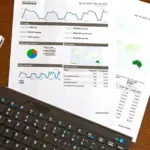Off-page SEO: Better rankings with backlinks!
Off-page optimization is one of the two important pillars of search engine optimization and helps websites be found better in search engines, so more relevant users visit the website.
In addition to on-page optimization, the off-page area of search engine optimization is important for the success of a website. In this blog post, we will show you how you can use off-page SEO measures profitably for your website. Here we go!
Off-Page SEO vs. On-Page SEO
What are the basic differences between off-page SEO and on-page SEO? In a nutshell, on-page SEO is the opposite of off-page SEO. On-page optimization includes all measures that are taken on a website for search engine optimization in order to achieve a better ranking in organic searches. This includes, among other things, the optimization of the meta data, the images, and, above all, the entire content of the website. As we know, content plays an essential role in the allocation of ranking positions. Relevant content ensures that the website can be found and, in the best case, also ensures that anonymous website visitors become paying customers. Learn more about on-page SEO here.
Like on-page SEO, off-page SEO is a part of search engine optimization and is considered the counterpart of on-page optimization. Off-page optimization includes all measures that are taken away from your own website for a better ranking. The most important factors for off-page optimization are high-quality backlinks and optimized anchor texts.
It is important to understand that off-page and on-page SEO are not to be considered as individual measures. Only in combination with an optimized on-page SEO page and relevant backlinks does the page have a chance to rank and thus lead new website visitors to the page. Of course, technical optimization of the site is required.
Off-page SEO: What has changed?
Everything was better before. I swore I wouldn’t quote my parents. It wasn’t better, it was easier. Just a few years ago, the search engine algorithm was not so sophisticated that it could assess the value of different links, for example, in terms of relevance. A great starting position for SEOs: only masses of links from web directories and so-called link farms had to be set up, and the pages found their way into the top search engine rankings. This ensured that even mediocre and bad content made it into the top positions. This was neither effective for the search engine nor for the user.
Today, everything is better, but also more complicated: link building has to be done with care. Irrelevant links quickly have the opposite effect on the search engine and have a negative impact on the rankings. Everything that looks like manipulation of the rankings in the search engine and is not user-oriented will be punished with falling rankings.
For the first time, the focus is also on the quality of the links established and ensures that links must be available in sufficient quantity and of the required quality.
Off-page SEO: The Strategy for Sustainable Link Building
For the sustainable development of relevant links, we have put together a few strategies that have proven to be very helpful and contribute to valuable links.
Content syndication
Content syndication describes the placement of your own website content on the websites of third parties with the aim of obtaining links via the content provided. In the classic sense, one speaks here of guest contributions , which enable the exchange of content.
+ blog comments
Blogs thrive on interaction. Although most blog comments are set to nofollow, you still benefit from helpful comments. They ensure that you attract the attention of the website operator and the readers. In addition, the links under helpful comments can ensure direct traffic to your own website project.
+ Interviews with influencers
A good format for creating helpful content, which in most cases leads to a good backlink, is interviews with partners that have a high reach. Again, helpful content matters most.
+ high-quality business directories
Business directories are not link farms; in most cases, well-managed business directories provide the necessary added value, and the links are targeted for the SEO results of the link-receiving site. These business directories are especially important for local businesses and local SEO.
+ Press releases / publications
Press releases bring reach and, if things go well, links. For this reason, a PR strategy belongs in every off-page SEO strategy.
+ Wikipedia entries
Many companies have the opportunity to create Wikipedia entries and thus benefit from the reach of the free encyclopedia.
+ linkbait
Link baits are usually free goodies, such as white papers, video courses, webinars, or other formats that encourage third-party websites to share the link. Link bait campaigns are very effective, but require a certain amount of effort in order to be carried out successfully since the creation of the free goodies is usually very resource-intensive.
Ranking factors for off-page optimization
In addition to the right off-page strategy, the ranking factors of off-page optimization also play an important role. As we already know, quality counts here. In order to be able to evaluate them, we first have to understand which ranking factors are important for Google and which have an influence on the search engine optimization of a website. In the following, we will go into the different ranking factors of off-page optimization:
1.Domain Authority
A website’s domain authority describes its relevance to a specific industry or subject area. To do this, search engines crawl websites and assign them authority on a specific topic. Important elements that make up domain authority are:
- domain trust
- high-quality content (keywords, alt tags, etc.).
- quality backlinks
- age of the website
- Number of page views
- Dwell time/bouncing rate
These characteristics define the domain authority or relevance of a website and affect search engine rankings. The domain authority can therefore be evaluated as an indicator of the relevance of a website. However, this indicator cannot be defined as a generally defined KPI but is calculated differently depending on the SEO tool.
2. Page Authority and Keyword Relevance
Unlike the domain authority, which refers to the entire domain, the page authority only refers to the individual subpages of a domain. Each individual page is evaluated for its authority. A high domain authority does not rule out having a low page authority on some subpages. The other way around as well. Therefore, it is important to note that both factors influence each other. Page authority is primarily about the quantity and quality of the backlinks to the subpages as well as the use of optimized anchor texts and content with keyword relevance .
3. Brand Authority
The brand authority is the authority of a brand. Websites from well-known brands with high brand authority have an advantage in search engine rankings, since the search engine has a certain amount of trust for the brand and website and rewards them accordingly. There are various methods to make your own brand better known, such as image and brand campaigns. Company mentions or mentions of the brand in the press and other publications can contribute to higher brand authority.
Evaluation criteria for backlinks
In addition to the ranking factors of off-page optimization, which are defined on the basis of the entire website, there are also certain evaluation criteria for the backlinks of a website. As we already know, quality plays a more important role than quantity, but the number of backlinks and referring domains also contributes to better rankings . The prerequisite here is that the backlinks are of high quality. In the following, we explain which evaluation criteria are important for backlinks.
1. Popularity
This is primarily about the popularity of the linking sites. The overall authority of the website and its trust level also contribute to how the backlinks are rated by Google.
2. Relevance
It is important that the linked pages are relevant to your website and show relevance to the topic. Because the Google algorithm is now so smart that it recognizes whether the linking websites are thematically related to the target website, a lack of contextual content leads to a poorer rating for the backlink.
3. Anchor Text
Anchor text, also known as anchor text, is the clickable text in a hyperlink on your web page. Backlinks are therefore at best provided with an anchor text, as this plays a decisive role in the evaluation of the backlinks. Anchor texts describe the content of the target page with relevant keywords and are therefore an important indicator for the search engine. As a result, Google takes the information and recognizes whether the target page is relevant for the search.
4th position
The position of the backlink on a website also has an impact on the backlink rating. The backlinks that are located directly in the content are rated best. Backlinks that are in the header or in the navigation of the website are therefore rated lower.
5. Attribute
In order for your website to benefit optimally from your backlinks, the following attributes of the backlink are crucial: This attribute instructs the search engine crawler to follow the link. With nofollow attributes, the search engine is informed that this link should not be followed by the crawler and should not be included in the search engine’s ranking.
6. Speed
Backlinks that are built up too quickly give the search engine an unnatural link profile. If there is a suspicion of link purchase, which can be penalized by Google.
Off-page SEO: Check existing links
Not only the construction of fresh links is an important part of the off-page SEO strategy, but also the targeted removal of existing links that do not offer the user any added value. Such backlinks are not effective for ranking positions. For this reason, it makes sense to also put existing links to the test and devalue harmful links with the Google Disavow Tool.
Since there are also competitors involved in negative SEO here, it makes sense against this background to check the existing links in regular cycles and to disavow links that do not bring the required level of quality. Various SEO tools can provide help in checking the backlink profile of a website. With professional SEO tools, existing backlinks can be regularly checked for toxic backlinks. With the export functions, these affected domains can easily be submitted for invalidation using Google’s Disavow Tool.
The conclusion to off-page SEO
Off-page SEO can quickly become very complex, and ignorance does more damage to the result than it provides the necessary benefit. With the right SEO strategy, you can bring your website into the top ranking positions and achieve high-quality links, which ideally not only ensure better ranking positions but can also help you receive additional and relevant traffic for your website. In any case, you should put on the quality glasses today in the area of off-page SEO and build links with a focus on quality instead of setting the target on quantity.
We would be happy to support you in establishing a tailor-made off-page SEO strategy for your company. Together, we will find the right solution for your industry. Just get in touch with us!





